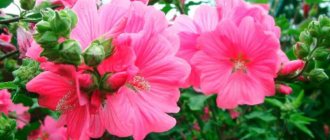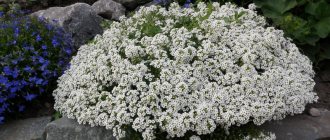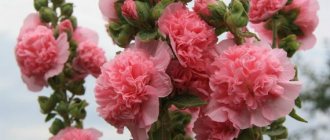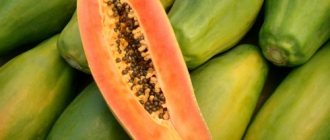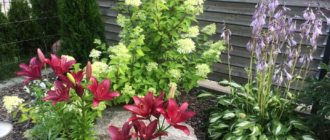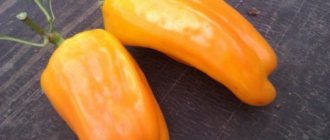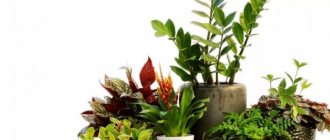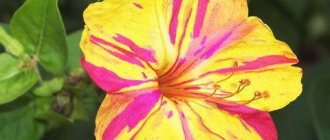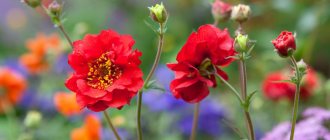Alstroemeria is a rhizomatous perennial herbaceous plant native to South America. The plant is called the Peruvian lily or Lily of the Incas. The strange flowers of the culture surprise and amaze the imagination of even experienced flora lovers. Flowers do not lose their charm when cut for a long time. The plant is cultivated on an industrial scale; in greenhouses, the flower is forced twice during the year.
Planting these flowers is a great attempt to add a unique touch to your garden plot. Wonderful flowers have no aroma, so they will appeal to people prone to allergies. In the language of flowers, a bouquet of alstroemeria symbolizes a touching message: “You are so desirable!”
Description of the plant
Alstroemeria belongs to the family and genus Alstroemeria of the same name.
The Peruvian lily is rarely found in flower beds; it is often grown as a cut flower. This fragile flower can be found and purchased in flower shops. The plant has been known for a long time. Ancient Indian tribes attached magical meaning to alstroemeria flowers. The root is branched, large, and shaped like a spindle. The stems are straight, elastic, up to 150 cm high. Two types of shoots: vegetative (powerful leaves connected at the top) and reproductive (tiny leaves, equally distributed along the stem). The unique bright emerald leaves rotate 180 degrees around an axis during growth - scientists call this resupination.
The flowers form large umbrellas; there can be up to 30 inflorescences. Tiny flowers, 5 cm in diameter, similar in shape to lilies. The crop blooms in May. The colors of the plant are so different that everyone will easily choose their own shade. Scarlet, lemon, raspberry pink. Many varieties of flowers are decorated with dots or stripes. Flower shops sell alstroemeria seed mixtures, such as Alstroemeria Exotic Butterflies or Happy Moths. Flowers are easily pollinated by insects. The fruit is a capsule with seeds that scatter when ripe. The plant is propagated by seeds and root division.
In the language of flowers, alstroemeria has many meanings. For those who understand the magical language of flowers, a bouquet of luxurious Peruvian lilies means friendship and good wishes.
Alstroemerias with golden petals symbolize success and luck. The purple petals of the flower mean that the giver is enchanted, and the pink shades of the buds indicate tenderness. Inca lilies with scarlet flowers are given as a declaration of love.
How to propagate alstroemeria
Vegetative propagation of alstroemeria involves dividing the bush. Start dividing when the bushes have grown well. It makes no sense to strive to get as many divisions as possible from the bush. It is better to divide into 2-3 parts, each of which will contain a well-developed rhizome and growth buds.
How to divide an alstroemeria bush photo rhizomes
Such divisions will take root successfully and bloom earlier. It is best to divide the bushes in the fall after the end of flowering; you can also carry out the procedure in the spring or summer (at the end of the first wave of flowering).
Carefully dig up the bushes, divide them into parts, treat the cut areas with a fungicide, and plant them immediately. Make planting holes of the appropriate size, place cuttings there, cover with soil, and water.
Types and varieties
There are many types of crops, differing in stem height, variegation of flowers and nuances in the growing process. Breeding specialists have created a colossal number of species varieties and hybrids.
Alstroemeria flower is a warm-loving crop. Modern experts develop varieties that consistently respond positively to the climatic conditions of the middle zone, which are quite harsh for the plant.
The varieties and species presented below are best suited.
Beauty
Alstroemeria Beauty
A delightful lilac alstroemeria, with a tall stem up to 170 cm high. It blooms in spring, and with impeccable care, lilac-colored flowers appear again.
Golden
Alstroemeria aureus lutea
Alstroemeria golden lutea is a plant reaching a height of 150 cm. Flowers with different colors: it varies from lemon yellow to orange. The main feature of this type of Peruvian lily is its comparative frost resistance. Representatives of the variety tolerate frosts down to -12°.
Orange
Alstroemeria Orange King
The culture is distinguished by its original leaves, bluish below, and golden-orange flowers. Blooms all summer. The inflorescence contains up to 30 flowers. There are several varieties: Lutea (yellow), Orange King (orange) and Dover Orange (orange-red). Alstroemeria Orange King or “orange king” is an extremely heat-loving plant, it needs to be covered in winter, otherwise it is not capricious.
Princess lilies
Alstroemeria Princess lilies
The variety grows well in containers. Plant height - 70 cm.
Peruvian
Alstroemeria peruviana
The variety is resistant to low air temperatures.
Brazilian
Alstroemeria brasiliensis
The stem is up to 2 m high. The petal is spear-shaped, scarlet or bronze in color. The inflorescences are fluffy and may contain more than 30 flowers.
Hybrid 'Regina'
Alstroemeria hybrid 'Regina'
The flowers are pink, the plant height is up to 200 cm. The first flowering is in mid-spring, repeated in the fall, but weaker and less bright. The distance between seedlings when planting is at least 80 cm. This variety is most actively grown in the country.
Red flowers similar to lily: amaryllis, hippeastrum and wallotha
As we have already said, amaryllis is represented by one species. This red lily-like flower is native to South Africa and grows to 50-70 cm in height.
Amaryllis belladonna has excellent decorative qualities, a very beautiful and bright flower.
Bright red amaryllis in a chic bouquet.
It is worth noting that there are garden forms not only with red flowers, but also with pink (Amaryllis belladonna major), light pink (Amaryllis belladonna minor).
HIPPEASTRUM
As mentioned above, amaryllis and hippeastrum are very similar to each other, and at the same time similar to lilies. Hippeastrum has beautiful large flowers.
The genus includes more than 75 plant species, which mainly grow in the tropical and subtropical climate zones of America.
- With the development of floriculture, many garden forms appeared. Hybrid varieties of hippeastrum are distinguished by a variety of colors.
Hippeastrums in red, orange, pink, white and purple colors are widely found.
Blooming hippeastrum
WALLOTA IS BEAUTIFUL
The Wallota flower is native to Africa and is a relative of the amaryllis. The plant has a smaller bulb size and narrower and longer leaves.
Flowers are mainly found in red shades, sometimes white and pink. Wallot is an unpretentious plant and easy to care for.
- For abundant flowering in summer, neither a cramped pot, a cold room, nor dry soil in winter will interfere with it. It grows very quickly so that you definitely won’t have a shortage of flowers.
When the children are separated from the mother bulb, the number of flowers increases even more. Small valottas bloom in the second year.
This indoor flower is similar to a lily in the shape of its inflorescences and gives no less positive emotions.
In summer, the plant loves light and water; it is not demanding on the soil. Ideally, grow in a mixture of turf and deciduous soil with river sand and humus. In winter, the main thing is to provide moderate watering; the flower can withstand up to +5-7 degrees.
Vallota the Beautiful
Plant care
The plant cannot be called too picky and whimsical. Caring for alstroemeria is not difficult, but there are a number of nuances that must be taken into account in order to continue to admire the flowering. This is a strange plant, and therefore requires thoughtful treatment and attention. Before planting, choose strong seedlings of the Lily of the Incas, select the ideal place on the site, or buy the correct indoor pot for this plant. They are preparing the ground.
The culture is thermophilic, but there are varieties that, with timely shelter, will tolerate mild frosts.
It is best to purchase plant seedlings or seedlings from flower shops or nurseries.
Before purchasing, carefully examine the seedling. It should be free of defects, signs of diseases and pests. Different varieties have different heights, so before purchasing, it is determined what kind of garden composition will be created.
Home care
Alstroemeria is successfully grown at home, but some features must be taken into account. The root of the crop is long and thin, so it is important to use a deep pot for planting, at least 30 cm high. There should be a hole at the bottom of the pot. An important element of caring for alstroemeria is choosing a comfortable place so that the plant develops harmoniously and grows actively. A corner where sun and shadow alternate each other throughout the day is perfect. Water the Peruvian lily every 3 days. There is no need to fertilize plants growing at home.
Greenhouse care
Alstroemeria is grown in a greenhouse on an industrial scale for cutting. Before planting, carefully prepare the soil, consisting of peat, sand, deciduous soil and humus. The earth is carefully dug up and treated with a disinfectant composition. To support adult plants, when planting, a special net is placed on top of the surface. They regulate and control the temperature in the greenhouse: when the foliage is growing, it is about +15°, when it blooms - +20°.
When constantly growing crops in greenhouses during the cold season, the temperature should be at least 10°. Proper dosed watering is carried out using the drip method. In winter, watering is reduced. The soil around alstroemeria is loosened in a timely manner. Nitrogen-potassium fertilizers are applied monthly, at least twice. In winter, alstroemeria needs additional lighting.
Outdoor care
Planting alstroemeria in open ground is quite simple. Alstroemerias are grown from seeds. In the spring, when the air and soil warm up to 20°, the seedlings are planted in the ground. The root system of this amazing beauty grows rapidly, so the planting holes are placed at a distance of approximately 50 cm from each other. At the bottom of each hole, to avoid stagnation of water, place a layer of gravel drainage and a little rotted compost on top. Place the plants in the holes, sprinkle with soil, slightly compacting the soil, and water generously. To prevent moisture evaporation, the ground around the flowers is mulched using peat or dry sawdust.
Further care
Caring for alstroemeria consists of proper watering, loosening, feeding, and shelter for the winter. Let's consider the nuances of each process separately.
Top dressing
Alstroemeria is fed 3-4 times a month. Before flowering, apply fertilizer with a high potassium content. From the moment the buds appear until the end of flowering, fertilizers with a low nitrogen content are introduced. Organic fertilizers are used (rotted mullein, bird droppings, wood ash), but in small quantities.
Watering
Water moderately once a week. The flower does not tolerate too moist soil, as a result of which its roots quickly rot. Regular mulching of the soil near the plant roots has a beneficial effect on soil structure and moisture.
The soil
On heavy soils, the Inca lily grows slowly and practically does not bloom. The acidity level suitable for the culture is pH 6.5. If the pH exceeds 7, then the value must be reduced by appropriately changing the composition of the soil with humus-forming substances. These include peat, animal manure, mature compost or special commercially available substrates.
When overheated, the root system begins to actively form, causing damage to flowering, therefore, to protect the roots, the soil around the roots is mulched. The ground is covered with a layer of compost, leaves, grass clippings or manure to a height of 3 cm. This nutrient layer simultaneously keeps the soil moist and suppresses the growth of weeds.
To grow alstroemeria at home in a pot, use a loose, moistened substrate.
Wintering
In autumn, the crop is not watered, the above-ground part is removed, and in order to prevent the soil from freezing, the area is covered with spruce branches, dry leaves, and covered with plastic film, which is sprinkled with a layer of earth or mulch. Mature plants are stronger and tolerate frost much better. In the south, alstroemeria need not be covered in winter.
In the northern regions, they try to dig up the tubers, dry them so that the roots do not rot, and keep them at positive temperatures.
Soil for alstroemeria
It is recommended to prepare a substrate for growing alstroemeria from sand, peat, leaf and turf soil (1:1:2:1 ratio) with the addition of a light concentration of potassium permanganate solution.
For planting seeds, a plastic box, container or individual cups are better suited.
Make a hole in the selected container where excess water can drain, and lay drainage on the bottom (you can use expanded clay, polystyrene foam or small pebbles). Important! Germination of Peruvian lily seeds should be carried out in greenhouse conditions, for which the containers are covered with plastic lids, glass or plastic film. Do not forget to remove condensation every time you ventilate; in just one day, the containers are opened for a short period of time 2 to 3 times.
How to grow alstroemeria?
Alstroemeria, like lilies, reproduces by seeds and division of the mother bush. The second method is easier, and alstroemeria will produce buds much earlier. At the risk of buying a tree of the wrong variety and color that you want, you will have to raise the desired beauty at home yourself. Alstroemeria seeds can be bought at any flower shop.
They use seedling planting, as well as the seedless method, planting seeds directly in open ground. Growing Inca lilies from seedlings seems straightforward, but to grow healthy plants, you need to follow the basic rules and avoid mistakes. The optimal time for sowing seeds to obtain seedlings is in early spring. When wondering how to grow alstroemeria, you need to know that the process of growing it is relatively simple and similar to growing seedlings of many flowers. The beauty lands in the flowerbed when stable, warm summer weather sets in.
When the bush of the plant has reached an impressive size and has flowered, divisions are taken from it for subsequent propagation. If the bush is still small, many divisions are not required from it; it is divided into 2-3 parts that have powerful, dense roots. The divisions will quickly take root and will charm you with buds early.
An important part of the Peruvian lily propagation process is pruning. An unpruned plant produces many buds, but they are tiny in size. In spring, the flowers are thinned out, leaving strong specimens, and about a third of the shoots are cut off. As it grows, remove faded leaves and dried flowers, cut off old stems, keeping up to 15 cm of shoots from the root. Pruning improves the appearance of the crop and prevents diseases.
Landing
When choosing a place for planting, the main preferences of alstroemeria are taken into account: light and light soil. Alstroemeria is grown by specialists in greenhouses and by amateur flower growers at home on their windowsills. Relatively frost-resistant varieties are grown in open ground. Varieties with a low stem are excellent for cultivation in containers that can be placed in different parts of the garden, and sent to the balcony or terrace for the winter. Varieties characterized by tall shoots bloom beautifully in flower beds and flower beds. The area for planting alstroemeria should be windless, sunny, dry, and drained.
For the successful development of flowers, one of the conditions is the presence of fertile, slightly acidic or neutral soil. Soils with a high proportion of sand are excellent. Alstroemeria grow slowly in soil with stagnant moisture, so before planting the plant, add peat and rotted manure. Before planting the crop, the soil is dug up, loosened, and compost is added.
Flower propagation
Alstroemeria flowers reproduce, like many other plants, by seeds and division of rhizomes. If a flower is grown from seeds, such a plant will bloom only after three years. Flower growers have a priority in propagating alstroemeria by dividing the rhizomes, since after planting the crop in the fall, alstroemeria will surprise with beautiful buds in the spring. To divide the rhizomes, adult three-year-old specimens are taken; at least five buds remain on each division. This division provokes the rejuvenation of plants and controls their growth, preventing them from growing too actively.
Growing from seeds
Growing alstroemeria from seeds is a troublesome task.
Hybrid plants may lose their morphological characteristics, so they are not grown from seeds, but specific varieties of alstroemeria are perfect for this procedure. When collecting seeds yourself, you need to remember that after ripening the fruit cracks and the seeds spread around the plant. It is advisable not to lose the seeds, so the faded bud is wrapped in a piece of gauze, then the seeds will not fall by.
For favorable cultivation of alstroemeria, before sowing, the seeds are stratified so that they germinate faster and their germination rate increases. The seeds are placed in a damp cloth and refrigerated for one month, the temperature should be in the range of +1...+5°. Thus, the seeds are simultaneously exposed to cold and humidity. At the end of February, prepared seeds can be sown.
After stratification, prepare containers with a moistened substrate, plant the seeds to a depth of no more than 1 cm. Cover the top of the container with glass or film. Favorable temperature for seed germination is +20°. After a month, shoots appear. Seedlings dive after the appearance of 3 leaves. Seedlings are planted in open ground in May. Flowers grown from seeds will begin to bear their first buds only in the third year.
Alstroemeria seedlings
Seedlings from tuber parts
This method is used to grow hybrid alstroemeria varieties that will bloom the following year. The procedure for dividing the rhizome is carried out after the beautiful alstroemerias have faded. However, some gardeners do this at any time of the year. Carefully dig up the bush of the plant without damaging the roots, divide the rhizome into 2-3 parts. Each part should have an impressive root system. The cut areas must be treated with a disinfecting solution or charcoal. After division, Alstroemeria specimens are planted. After division, plants will take root for quite a long time, so they need proper care.
Pests and diseases
The beautiful alstroemeria is resistant to diseases and pests, but with excessive watering it can be affected by gray rot. At the first signs of this fungal disease (a fluffy gray coating on ground organs), the affected parts of the plant should be removed and the bushes and the soil around them should be treated with a fungicide solution. Specimens severely affected by gray rot should be removed so that they do not infect neighboring plants.
- Amaranth: growing from seeds, types and varieties
If alstroemeria is poorly cared for, it can be affected by spider mites or caterpillars. Caterpillars are destroyed with insecticidal preparations, and ticks with acaricides. Drugs such as Actellik, Aktara and Akarin will cope with any type of harmful insects.
In the photo: Blooming hybrid alstroemeria in the garden
Sometimes alstroemeria can be damaged by slugs that eat its leaves. To protect flowers from mollusks, mulch the surface with coarse bark or fence the area with a ditch with crushed stone, through which slugs will not get over.
Alstroemeria in landscape design
In landscape design, alstroemeria is planted next to noble roses, since these flowers are opposite to each other; the elegance and elegance of the Peruvian lily favorably sets off the captivating and power of the thorned enchantress.
Alstroemeria varieties with low stems are wonderful for decorating garden paths and flower beds. Low-growing charms are sometimes grown in pots and placed on terraces and loggias. Alstroemeria varieties with tall stems can be planted in the background of flower beds or placed in a group against the background of the lawn.
The meaning of the alstroemeria flower in combination with scarlet roses in the language of flowers: “I give you my hand and my heart!” The presented bouquet says that the girl is unique and extraordinary, means genuine admiration and sadness without a beautiful chosen one.
These flowers are also good in bouquets because they have no aroma, which means they are suitable for allergy sufferers.
How to use the flower?
Alstroemeria is a magnificent plant that is used both for decorating the site and for cutting into bouquets.
Combination
The combination of alstroemeria and chrysanthemums looks brilliant. Either chrysanthemums and alstroemerias that match in color are planted, or the pastel colors of some flowers become the background for the bright inflorescences of others. They go well with gerberas and irises - the union looks very decorative, especially if you use blue, pink, orange and scarlet shades.
Alstroemeria and eustoma combine and harmonize with each other: their buds slowly bloom, giving their beauty.
Undoubtedly, growing alstroemeria poses some difficulties, but with a little effort, everyone can admire the overseas miracle in their own area.
Alstroemeria – photo
Alstroemeria, with its beauty and elegance, can radically transform any garden or flowerbed. Just look at the photo, how good and varied it is!
Possible diseases and pests of flowers
This type of flower in all its varieties is exposed to pests when grown:
- slugs;
- thrips;
- spider mite;
- leaf-eating caterpillars;
- whiteflies and others.
All parts of the flower, including stems and leaves, are treated at the slightest suspicion of disease or damage. The affected areas of the plant are removed from the flower.
The fungicide solution helps during rainy periods; it is used to treat flowers for preventive purposes and as protection against rot.
Loading…
Not so long ago, strange flowers appeared in flower shops in all cities of Ukraine - alstroemeria. Although it is more correct to call them Alstroemeria, since they were named after the Swedish botanist Claes Alstroemer. These flowers have captured attention and earned recognition due to their many advantages over their peers. In its natural environment, alstroemeria prefers the cool slopes of the Andes, Peru, and Brazil. In the wild you can find only botanical varieties, of which there are quite a few - about 60 species. And those beauties that we have the happiness to observe are hybrids and are grown on special plantations.
Amazing flower, let’s take a closer look at it
- Alstroemeria in its homeland is usually called the Peruvian lily, the lily of the Incas. Being a herbaceous perennial, the plant is capable of blooming 2 times a year and in duration eclipses many of the flowers we are accustomed to. Peoples who were lucky enough to live in the regions where alstroemeria grows used its flowers in traditional rituals and simply for decoration. Even among botanical species there is a wide variety of colors, let alone hybrids. Due to its high variability and fabulous colors, many call alstroemeria an orchid.
Not everyone has yet remembered the tricky name, but many are already asking “those flowers that look like small colored lilies.”
- The differences in color and shape within one species are impressive. There are miniature varieties, about 60 cm, and there are also 2-meter colossi with large flowers. For cutting, an average length of about 120 cm is often used. This is one of the charms of this wonderful flower. Given the length of the stem, it is possible to create compositions of incredible shapes and sizes without additional equipment. Whatever the length of the alstroemeria leg, the bunch of buds is always located only at the top. Having cut it to the required length, the florist can easily place the flower in a tall bouquet, in a standard assembled bouquet about 50 cm high, and in a basket of flowers about 15-17 cm high.
Mono bouquet of alstroemerias
- From alstroemeria flowers alone it is possible to create a huge number of color combinations or single-color mono-bouquets. The varietal diversity of hybrid forms numbers about 190 units and work does not stop. Along with roses, alstroemeria can be of the most unimaginable colors. A huge number of light tones, many bright saturated colors. The flower is often painted with stripes, dashes and dots. You can also find single-color, two-color, and spotted flowers. Whatever the color variation of this flower, you will definitely love the bouquet of fluttering moths.
- There is a slight drawback to the mini lily - it has no scent. However, for some this is a decidedly positive quality of the flower. Many people have unpleasant associations with oriental lilies due to their strong, intrusive aroma. A disease such as asthma forces people to give up many smells, but the odorless alstroemeria can act as a colorful alternative.
- The entire length of the alstroemeria stem has beautiful waxy leaves. This makes it possible not to add additional greenery to the bouquet. The leaves of the flower look harmonious with other flowers in a combined bouquet. Florists create completely different compositions by clearing the stems of leaves. Then we will get a bright, lush bouquet on a long green stem.
- Another advantage of choosing alstroemeria is its unprecedented durability. Provide it with cool conditions and the bouquet will easily last 2 weeks. Unopened buds will bloom, changing the flower pattern every day.
With a well-chosen planting site and high-quality agricultural technology, the Brazilian lily will grow and bloom in Ukraine. But it is extremely difficult to ensure low temperatures in summer and relatively high temperatures in winter without a greenhouse or conservatory. Growing and obtaining a large cap of colored moths is an incredible daily work. When buying a bunch of alstroemeria, treat it like an overseas queen, with respect and honor. Place the bouquet in a crowning place indoors and enjoy the beautiful miracle of nature.
Suitable suite for alstroemeria
The beauty of a flower is revealed only in the right environment. In the combined bouquet, alstroemeria is one of the soloists, it’s hard to outshine it. Either adds a bright touch or creates white lace - it is beautiful in any role. Bouquets of alstroemeria and roses are good; alstroemeria with primroses looks beautiful. This is an excellent plant for filling voids - openwork, bright with abundant shiny foliage. Alstroemeria is irresistible both in its loose form and in its bud state. It was quickly noticed by wedding florists and is successfully used both for bride’s bouquets and for wedding decorations.
Wintering alstroemeria
Alstroemerias definitely need shelter for the winter. Before the onset of cold weather, shoots are cut at a height of 10 cm above the soil surface. Then mulch the plantings with available material: sawdust, dry leaves, peat, etc., you can cover the plantings with non-woven material.
If the winters in your region are harsh, especially if the bushes are very young, they should be treated like chrysanthemums. Dig up in the fall and store in the cellar until spring. In most cases, alstroemerias overwinter well in the open ground; there is no need to resort to such radical measures. In the conditions of central Russia, they will overwinter under mulch, and in the southern regions they will not need shelter at all.
